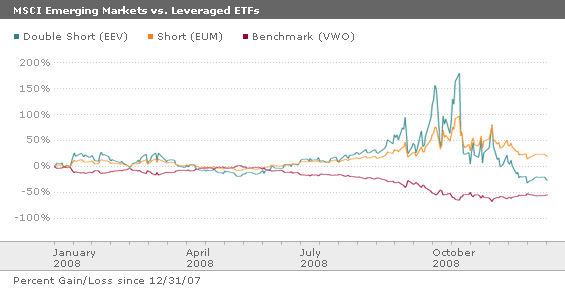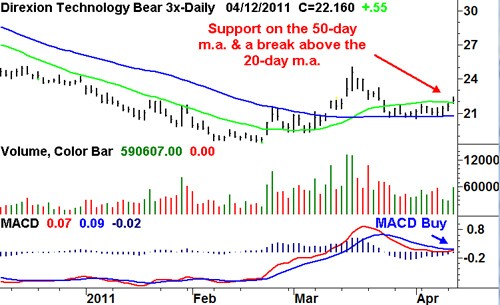Leveraged And Inverse ETFs Not For Me
Post on: 10 Май, 2015 No Comment

If the only tool you have is a hammer, it’s tempting to treat everything as if it were a nail. — Maslow, 1966
This couldn’t be truer when discussing the use of leveraged and inverse ETFs. They can be excellent tools for day traders and those seeking specific access to exotic markets, such as inverse currency. But for those looking for leveraged returns or downside protection, it is best to look a little deeper into the toolbox and select some other tools.
There are some excellent articles on Seeking Alpha, such as this one. that discuss the problems with these types of ETFs. So I won’t go into that, other than to note that tracking error can be significant over long periods of time. Under some circumstances, it can be so off that the result is the opposite of the intended result. Wow!
Instead, let’s look at these ETFs and compare them to other tools in the toolbox. By my count, there are over 150 leveraged and short ETFs. Given that, far and away, the most amount of money is devoted to ETFs that mimic the S&P 500 — financials and small caps — I’ll look at the tools that work well for these and leave the exotics alone.
Let’s first examine the double longs (2X). With the S&P 500 around $1,315, let’s assume an investor wanted to invest $13,200, looking to mimic a $26,400 investment. Using the 2X S&P500 ETF (NYSEARCA:SSO ), he or she would only have to pony up $13,200. So, the investor would get 2X the return (adjusted for tracking error) for 1X the cost.
I think that there is a much better tool in the toolbox. I would prefer to buy 2X deep-in-the-money (DITM) call options.
For example, the S&P 500 ETF (NYSEARCA:SPY ) is trading at $132.07. The December 2012 $75 strike costs $57.33. First step in the analysis notes that this $57.33 represents only 26 cents extrinsic cost. The balance of $57.07 represents intrinsic value. This means it will track the SPY with 99.55% accuracy ($57.07/$57.33). The Delta of +1 confirms this.
To invest the equivalent of $13,200 would mean buying one option at a cost of $5,733. But I want to mimic a 2X return, so I buy two options at a cost of $11,466.
In the end, I mimic a 2X return with near-perfect tracking and actually can accomplish it with only $11,466 instead of $13,200 — nearly a 15% discount.
Now, if an investor was looking to get in/out in a day or so, the SSO bid/ask spread is slightly more favorable than the option bid/ask. But, on just two options the difference is only about $60. This will be, more often than not, more than offset by the accuracy in tracking. This is especially evident if the position is held for longer durations. Of course, the same methodology can be used for 3X or whatever you want to devise.
What about the short and leveraged short ETFs?
Let me state that investors considering shorting the S&P 500 ETF should, in the first place, have more than average expertise in the market. And if they have this higher level of expertise, they also probably have margin accounts.
So my first question is simple: Why not just short the S&P 500 ETF outright? In fact, it is self-evident that this is the proper tool designed for this purpose. A direct short is simple, uses margin (not cash), has no tracking error, is easily closed out and has a bid/ask spread a fraction of the most popular short S&P 500 ETF (NYSEARCA:SH ).

The answer, therefore, must lie in the inability of the investor to institute a short such as exists in IRA accounts. So, does the IRA toolbox hold a better tool?
I would like to think that any investor considering a leveraged short ETF is looking at very short durations and not treating like a long-term strategy. So, buying a far-dated DITM put is not an appropriate tool. In this situation, a nearer-term put is appropriate.
For example, let’s say an investor is considering shorting $13,200 worth of the S&P 500 (100 shares of SPY). If he or she used the SH ETF, he or she would pony up $13,200. On the other hand, the investors could buy next week’s DITM $142 put on the SPY at a cost of around $10,500. Using the same comparative methodology, this would track with only 93% accuracy, but the bid/ask cost differential is only about $20 per option ($100 share position).
In this case, the DITM option tool doesn’t have an advantage. This is, in large part, a result of the ex-dividend date in a few days, which adversely affects the cost of put options. At other times, it should work better, and I suggest the reader go through the exercise when they are considering buying the SH ETF.
Though I won’t detail it here, it is worth mentioning that using synthetic option longs and shorts (sometimes referred to as combos) can be used instead of DITM calls or puts. They are very effective and use even less cash outlay and near perfect tracking. But nothing beats the DITM option for simplicity.
Conclusion: Leveraged and short ETFs have their place. For the day trader and exotic investor, they are perhaps the right tool for the job. But for most applications they are a hammer, when a screwdriver or wrench might be a better tool. Most investors could improve their results significantly by looking a little deeper into the toolbox.
Disclosure: I have no positions in any stocks mentioned, and no plans to initiate any positions within the next 72 hours. I also buy and sell options on SPY .














